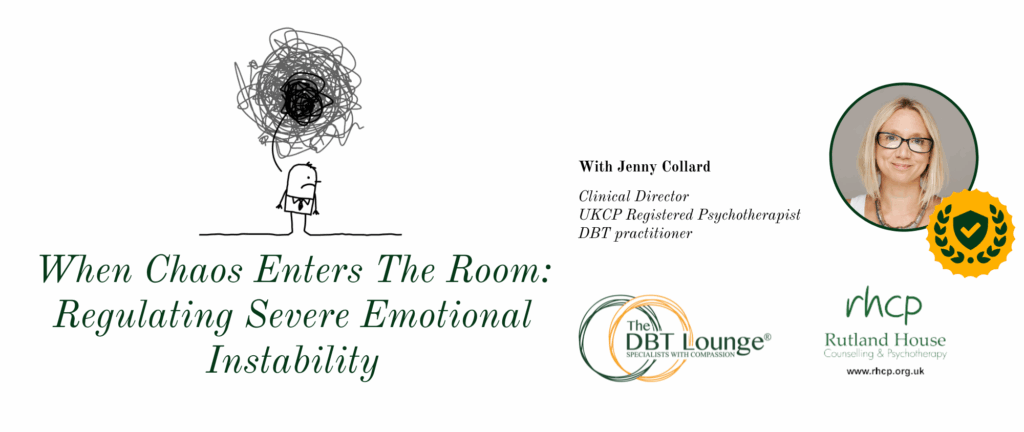
When Chaos Enters the Room: Navigating Emotional Dysregulation in Therapy
Published: July 7, 2025
In a recent Virtual Café CPD event, Jenny Collard, UKCP-registered psychotherapist and Clinical Director at Rutland House Counselling & Psychotherapy in Leicester, delivered a powerful training session titled “When Chaos Enters the Room: Working with Severe Emotional Dysregulation.” The session offered both foundational knowledge and actionable strategies for therapists working with highly dysregulated and emotionally chaotic clients – a challenging, yet rewarding therapeutic landscape.
Understanding Emotional Dysregulation
Jenny began by demystifying emotional dysregulation, defining it as emotional responses that don’t align with the current situation—either in intensity or type. These are often accompanied by behavioural chaos, such as impulsivity, relationship instability, and self-sabotaging patterns. Emotional and behavioural dysregulation frequently reinforce one another, creating a cycle that traps clients in distress.
Drawing from DBT’s biosocial theory, Jenny explained that emotional dysregulation arises from a mix of biological sensitivity and environmental invalidation – a reminder that not all distress stems from trauma. Understanding the full picture requires a nuanced approach that takes both nature and nurture into account.
Therapist as Observer and Participant
An essential theme of the training was using the therapist’s own emotional and bodily responses as tools. Jenny emphasized relational assessment, which includes noticing how clients make you feel and what bodily reactions are evoked during sessions. This “felt sense” can be a rich source of information for clinical formulation and understanding client dynamics.
Five Core Strategies for Working with Chaos
Jenny offered a framework of five strategic pillars to support therapists in their work with dysregulated clients:
- Comprehensive Assessment
Start strong with structured and relational assessments. Understanding what’s happening between the therapist and client is just as important as diagnosing what’s happening within the client. - Clear Goals and Motivational Techniques
Use DBT strategies like devil’s advocate, foot in the door, and door in the face to boost client motivation. Set specific goals around reducing self-harm, increasing emotional tolerance, and improving emotional clarity. - Relational Observation
Use your senses to track a client’s body language, tone, and energy. Then, gently inquire about what might be happening internally. This intervention enhances the client’s awareness and deepens the relational space. - Dialectical Thinking
Balance acceptance and change. Jenny recommends an 80/20 split—80% acceptance, 20% change. Use interventions like “share the dilemma” to help clients hold two truths without flipping into blame or shame. - Mindfulness and Validation
Validation isn’t just a nice-to-have—it’s a strategic tool. Jenny introduced the “and yet” technique to validate emotional experiences while gently steering clients toward behavioural change. She also shared practices for developing mindful objectivity, helping clients observe their experiences without immediate reaction.
Building Emotional Literacy
Clients often lack the language to describe their internal worlds. Jenny encouraged therapists to help clients build emotional narratives using metaphors, journaling, and emotion wheels. This improves not just expression, but also emotional processing and interpersonal connection.
Key Techniques for Emotional Regulation
Therapists were introduced to several practical techniques, including:
- “Ride the wave” – teaching clients to tolerate emotional surges without acting on them.
- “Checking the facts” – a worksheet-based method to evaluate whether emotions match reality.
- Body posture shifts – altering physical stance to shift emotional intensity.
- “Lean in or lean out” – helping clients decide whether to embrace or detach from an emotional experience.
What’s Next?
The group committed to implementing the following in their practice:
- Use dialectics and maintain balance between acceptance and change.
- Integrate the “share the dilemma” script into sessions.
- Apply relational observation techniques consistently.
- Enhance client emotional literacy through metaphor, journaling, and psychoeducation.
- Guide clients in using “checking the facts” and “ride the wave” methods.
- Practice the “and yet” validation technique.
Final Thoughts
Jenny’s session was a rich blend of clinical insight, practical tools, and relational wisdom. In working with chaos, therapists are reminded to stay grounded, curious, and compassionate. The message was clear: when we validate chaos and invite change, we create space for transformation—one wave at a time.
Stay tuned for Bruce’s upcoming session on “Humour in Therapy” 22nd August 2025 1pm – exploring how to use laughter as a therapeutic tool without losing depth. Book at : The Therapists Virtual CPD Café | Eventbrite
Want to know more about DBT, or want to discuss training for your team around managing emotional dysregulation?
Get in touch and come take a seat with us at The DBT Lounge
📞 0116 416 16 26
💻 info@rhcp.org.uk / www.rhcp.org.uk
📸 Instagram: @dbtlounge – https://lnkd.in/emStjJ6d
🔗 LinkedIn: The DBT Lounge – https://lnkd.in/eCazyUwU



